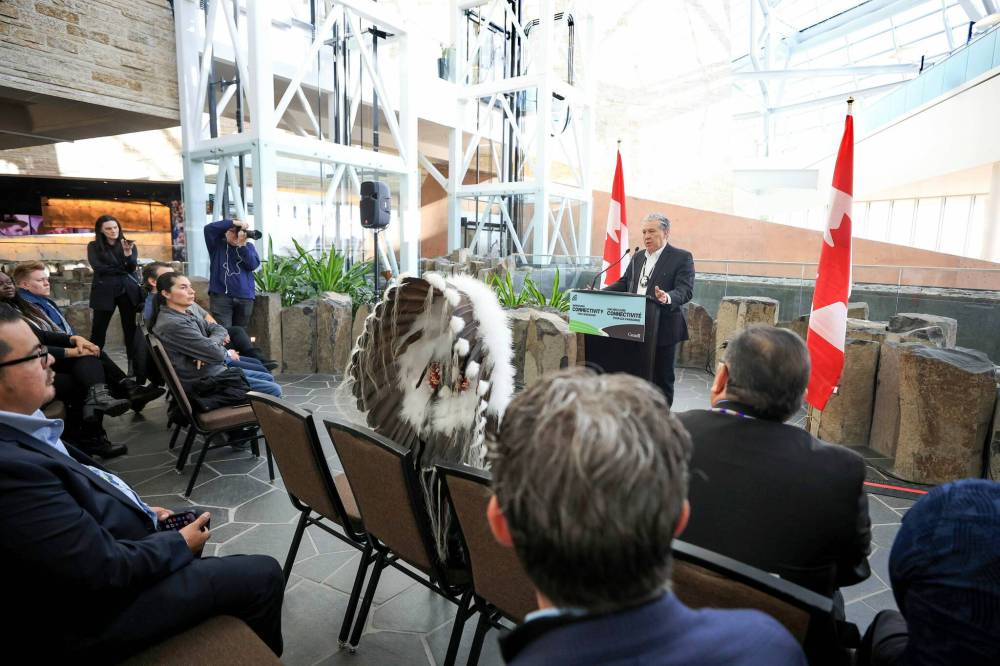Opening gates on ‘untapped opportunity’
Ottawa puts $38M into projects bringing high-speed internet to 14 rural Manitoba communities
Advertisement
Read this article for free:
or
Already have an account? Log in here »
To continue reading, please subscribe:
Monthly Digital Subscription
$0 for the first 4 weeks*
- Enjoy unlimited reading on winnipegfreepress.com
- Read the E-Edition, our digital replica newspaper
- Access News Break, our award-winning app
- Play interactive puzzles
*No charge for 4 weeks then price increases to the regular rate of $19.00 plus GST every four weeks. Offer available to new and qualified returning subscribers only. Cancel any time.
Monthly Digital Subscription
$4.75/week*
- Enjoy unlimited reading on winnipegfreepress.com
- Read the E-Edition, our digital replica newspaper
- Access News Break, our award-winning app
- Play interactive puzzles
*Billed as $19 plus GST every four weeks. Cancel any time.
To continue reading, please subscribe:
Add Free Press access to your Brandon Sun subscription for only an additional
$1 for the first 4 weeks*
*Your next subscription payment will increase by $1.00 and you will be charged $16.99 plus GST for four weeks. After four weeks, your payment will increase to $23.99 plus GST every four weeks.
Read unlimited articles for free today:
or
Already have an account? Log in here »
Hey there, time traveller!
This article was published 15/11/2024 (351 days ago), so information in it may no longer be current.
Ottawa has tabbed more than $38 million to expand high-speed internet access to 14 rural, mostly Indigenous communities in Manitoba.
The bulk of the money to be drawn from the federal government’s $3 billion Universal Broadband Fund went to projects bringing fibre optic networks to Norway House Cree Nation ($12 million) and Pimicikamak Cree Nation ($14.4 million) — two of the largest First Nations in the province, which previously relied on land-line dial-up or fixed wireless line-of-sight service.
Some 3,500 households are to be connected across the four projects, including those in Berens River, Bloodvein and Sapotaweyak Cree Nation.

RUTH BONNEVILLE / FREE PRESS
Liberal MP Dan Vandal makes an announcement Friday at the Canadian Museum for Human Rights in Winnipeg about improving high-speed internet access in rural Manitoba.
The construction and design of the systems were done by Indigenous-led companies. Indigenous-owned internet service providers are being created for their own communities.
“Internet is no longer a luxury for Canadians. We know how important being totally connected is in this day and age. It levels the playing field for our remote and Indigenous communities in Canada,” Liberal MP Dan Vandal, minister of PrairiesCan, said Friday in Winnipeg.
Edward Albert, a councillor from Norway House, agreed, saying: “This is not just about internet speeds, but it’s about creating access to opportunities, better health-care resources, enhanced education programming and new avenues for remote work.”
The stated goal of the federal government is to have access to high-speed internet in every community in Canada by 2030. Today, about 95 per cent of communities have access, up from 79 per cent in 2014.
Vandal acknowledged the province has some catching up to do. Only 85 per cent of Manitoba communities have access today, up from 70 per cent in 2017.
It has long been a source of frustration and sometimes anger from local First Nations.
Part of the problem for remote communities, especially in the North, arguably where it is needed most, is that it is hard to access the internet backbone or back haul.
In some case, these projects announced Friday have laid fibre optic cables more than 100 kilometres to get to the communities.
Indigenous-owned companies like Broadband Communications North and ODK Engineering, out of Swan Lake First Nation, designed and built the systems.
David Muswaggon, an elected member of the PCN executive council, said there was a lot of perseverance and dedication required to get the project completed.
“We have a passion to strive for objective standards for our people across Canada,” he said. “It is doable, but comes with blood, sweat and tears.”
Muswaggon also said it was a true test of reconciliation, after applying for funding for many years but being turned down in favour of projects with more traditional backers.
Representatives of the communities involved spoke of the growing technical capacity among their people. “The sky will be the limit,” Muswaggon said.
In Cross Lake, a locally-owned entity will run the system as the internet service provider.
“We’re the new kids on the block as ISPs,” Muswaggon said. “But it’s not going to be free. We will run it as a business.”
In an emotional speech, Sapotaweyak Chief Nelson Genaille said his community was excited about acquiring new lab services, including X-ray, but because of poor internet service they were not able to utilize Manitoba Telehealth. A new school built in the community in 2007 was never able to access online education programs.
“Now, that opportunity is there for us to do what we can do,” he said. “This is an untapped opportunity.”
martin.cash@freepress.mb.ca
History
Updated on Monday, November 18, 2024 11:15 AM CST: Corrects reference to past community access to high-speed internet.

